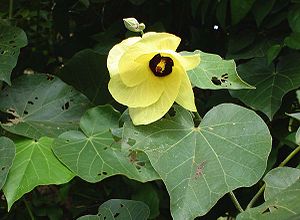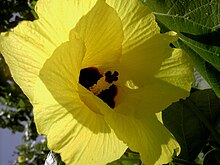Linden-leaved marshmallow
| Linden-leaved marshmallow | ||||||||||||
|---|---|---|---|---|---|---|---|---|---|---|---|---|

Linden-leaved marshmallow ( Talipariti tiliaceum ) |
||||||||||||
| Systematics | ||||||||||||
|
||||||||||||
| Scientific name | ||||||||||||
| Talipariti tiliaceum | ||||||||||||
| ( L. ) Fryxell |
The Hárslevelű Marshmallow ( Talipariti tiliaceum ), even though he is no longer the same genus as the Roseneibisch heard when Linden Roseneibisch called, is a plant species from the subfamily of Malvoideae within the family of mallow (Malvaceae). It has a pantropical distribution and naturally thrives mostly on the coast and on the banks of streams. It is used in many ways, for example used with some varieties as an ornamental plant. The German trivial names and the specific epithet tiliaceum refer to the similarity of the leaves of this species with those of linden ( Tilia ).
description

Appearance and leaf
The linden-leaved marshmallow grows as an evergreen shrub or tree , which usually reaches heights of 3 to 8 meters, sometimes up to 10 meters and trunk diameters (breast height diameter) of up to 60 cm. The bark is hairy with tiny and soft star- or spider-shaped trichomes and later becomes more or less bald. The bark is gray-white.
The alternate leaves are arranged in a petiole and a leaf blade. The 4 to 12 cm long petiole is more or less dense, particularly dense in the upper area, with downy hairs and they often do not merge completely into the center of the leaf blade. The leathery, green leaf blade is usually 6 to 13 cm long and somewhat wider than it is long and usually broadly ovoid, sometimes weakly pentagonal or almost circular, with a deep heart-shaped blade base and a short, pointed upper end. The leaf margin is smooth to indistinctly serrated or notched. The leaf surfaces are two-colored, the upper side of the leaf is glabrous and the underside of the leaf is dense with tiny, gray-white star hairs, fluffy or almost bald. Seven to nine leaf veins extend from the petiole in finger-shaped ramifications and are raised on the underside of the leaf. The one to five main veins have extra-floral nectar glands 2 to 7 mm long on the underside of the leaf at their base. The outside fluffy hairy with star hair and inside bare stipules are at a length of 1.5 to 4 cm and a width of 8 to 14 mm oblong-lanceolate with a pointed or rounded upper end, have many cores and they leave at a fall annular leaf scars.

blossom
The flowers are solitary in the leaf axils, sometimes they are together at the branch ends in the axils of reduced leaves. There are two side-leaf-like bracts (Brakteolen) available. Above the joint, the fluffy-haired flower stalk with tiny star hairs has a length of 0.5 to 3 cm. The subcalych with hardly any fluffy hair is at most half as long as the calyx and cup-shaped with mostly eight to twelve, rarely up to twenty subcalyx teeth, with a length of 1 to 6 (rarely up to 20) mm teeth triangular to lanceolate with broadly rounded indentations .
The hermaphrodite flower is radially symmetrical and five-fold. The five 1.5 to 2 cm long, densely hairy sepals with star hairs are fused to one another up to a maximum of half their length and those with a length of 12 to 15 mm and a width of 6 to 8 mm usually have lanceolate-pointed calyx teeth a nectar gland on its midrib. The five petals that are free from one another, but fused with the base of the stamens, are ovate and usually 4 to 6 (up to 8) cm long. The petals of the natural forms are yellow and turn orange when withered and sometimes they turn dark greenish when drying; The bell-shaped corollas with a diameter of 6 to 7.5 cm can have a red to purple center. Cultivated forms can also have white, purple, or pink petals. The petals are densely hairy on the outside with tiny star hairs and glabrous on the inside. There are many stamens present. In the subfamily Malvoideae, the many stamens have grown together to form a tube surrounding the pistil , the so-called stamen tube or columna. The 2.5 to 3 cm long columna is pale yellow and bald and ends in five triangular teeth. The stylus has glandular hairs. The Columna is surmounted by five purple-colored scars with a diameter of about 2 mm.
Fruit and seeds
The five-chamber capsule fruit is 1.5 to 2 cm in length, which is almost the same length as the calyx, and with a diameter of 1.5 to 2 cm is almost spherical or slightly obovate. The capsule fruit is hairy on the outside with forward-facing yellowish or brownish trichomes. When ripe, the capsule fruit opens with five woody valves and contains many seeds. With a length of about 4 mm, the kidney-shaped seeds are glabrous on the outside and smooth or tiny papillae .
Phenology and chromosome number
Talipariti tiliaceum can bloom and produce fruit all year round in the tropics, unless a dry season causes an interruption. The main flowering time in China is between June and August.
For the number of chromosomes different results for are Talipariti tiliaceum var. Tiliaceum before: 2n = 80, 2n = about 92, 2n = 96.
use
The linden-leaved marshmallow is an ornamental plant in Fiji , Tahiti , Hawaii , Japan , Taiwan , southern China , Malaysia , Indonesia , Australia and the USA .
Talipariti tiliaceum is one of the most widely used trees in Polynesia .
The fibers of the young bark were used to make stable ropes, but also book covers and lying mats. The old bark, also called tapa, was chopped up and the Tahitian women made fiber skirts from it, which they wore in their traditional dances. In Hainan , too , fibers were extracted from the bast and used to make fishing nets.
The light wood was used to make door frames, planks, oars and outrigger boats.
The flowers are considered a remedy for bronchitis , hemorrhoids and abscesses .
Systematics and distribution
The first publication of this species was in 1753 under the name Hibiscus tiliaceus by Carl von Linné in Species Plantarum , 2, p. 694. Under the name Talipariti tiliaceum it is a type of the genus Talipariti , which was published in 2001 by Paul Arnold Fryxell in Contributions from the University of Michigan Herbarium , 23, p. 258. Other synonyms for Talipariti tiliaceum (L.) Fryxell are: Hibiscus elatus Sw. , Paritium tiliaceum (L.) A.St.-Hil.
Talipariti tiliaceum belongs to the genus Talipariti from the tribe Hibisceae in the subfamily Malvoideae within the family Malvaceae .
Talipariti tiliaceum is spread pantropically today. It owes its common English name "Beach Hibiscus" to the fact that it often grows near the beach.
According to Fryxell 2001 there are two varieties of Talipariti tiliaceum :
- Talipariti tiliaceum (L.) Fryxell var. Tiliaceum : The original range are the coasts of the Indian and west Pacific Oceans.
- Talipariti tiliaceum var. Pernambucense (Arruda) Fryxell : The range is the neotropical coastal areas.
swell
- Paul Arnold Fryxell: Talipariti (Malvaceae), a segregate from Hibiscus. , In: Contributions from the University of Michigan Herbarium , 23, 2001, pp. 225-270. Fryxell scanned in 2001 at biodiversitylibrary.org . (Section description, distribution and systematics)
- Ya Tang, Michael G. Gilbert & Laurence J. Dorr: Malvaceae : Hibiscus tiliaceus Linnaeus , p. 288 - online with the same text as the printed work , In: Wu Zheng-yi, Peter H. Raven, Deyuan Hong (eds.): Flora of China , Volume 12: Hippocastanaceae through Theaceae. Science Press and Missouri Botanical Garden Press, Beijing and St. Louis, November 19, 2007, ISBN 978-1-930723-64-1 . (Section description, distribution and use)
- Datasheet from Australian Native Hibiscus Family . (Section Description, Use and Distribution)
Individual evidence
- ↑ a b c d e f g h i j k l m Ya Tang, Michael G. Gilbert & Laurence J. Dorr: Malvaceae : Hibiscus tiliaceus Linnaeus , p. 288 - online with the same text as the printed work , In: Wu Zheng-yi, Peter H. Raven, Deyuan Hong (Ed.): Flora of China , Volume 12: Hippocastanaceae through Theaceae. Science Press and Missouri Botanical Garden Press, Beijing and St. Louis, November 19, 2007, ISBN 978-1-930723-64-1 .
- ↑ a b c d e f g h i j k l m n Fryxell 2001 scanned at biodiversitylibrary.org .
- ^ Linnaeus scanned in at biodiversitylibrary.org in 1753 .
- ^ Talipariti tiliaceum at Tropicos.org. Missouri Botanical Garden, St. Louis
- ↑ a b Talipariti tiliaceum in the Germplasm Resources Information Network (GRIN), USDA , ARS , National Genetic Resources Program. National Germplasm Resources Laboratory, Beltsville, Maryland.
Web links
- Private site (English).


